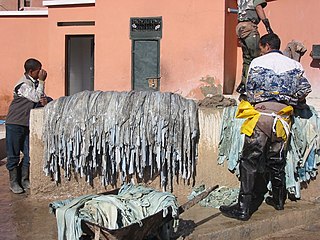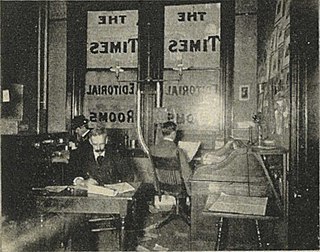Related Research Articles

Ernest Thompson Seton was an English-born Canadian-American author, wildlife artist, founder of the Woodcraft Indians in 1902, and one of the founding pioneers of the Boy Scouts of America (BSA) in 1910.

According to the Hebrew Bible, the tabernacle, also known as the Tent of the Congregation, was the portable earthly dwelling place of Yahweh used by the Israelites from the Exodus until the conquest of Canaan. Moses was instructed at Mount Sinai to construct and transport the tabernacle with the Israelites on their journey through the wilderness and their subsequent conquest of the Promised Land. After 440 years, Solomon's Temple in Jerusalem superseded it as the dwelling-place of God.

Tanning is the process of treating skins and hides of animals to produce leather. A tannery is the place where the skins are processed.

Editing is the process of selecting and preparing written, photographic, visual, audible, or cinematic material used by a person or an entity to convey a message or information. The editing process can involve correction, condensation, organisation, and many other modifications performed with an intention of producing a correct, consistent, accurate and complete piece of work.

Trail mix or scroggin is a type of snack mix, typically a combination of granola, dried fruit, nuts, and sometimes candy, developed as a food to be taken along on hikes. Trail mix is considered a great snack food for hikes, because it is lightweight, easy to store, and nutritious, providing a quick energy boost from the carbohydrates in the dried fruit or granola, and sustained energy from fat in nuts.

A tipi, often called a lodge in English, is a conical tent, historically made of animal hides or pelts, and in more recent generations of canvas, stretched on a framework of wooden poles. The word is Siouan, and in use in Dakhótiyapi, Lakȟótiyapi, and as a loanword in US and Canadian English, where it is sometimes spelled phonetically as teepee and tepee.
A hide or skin is an animal skin treated for human use. The word "hide" is related to the German word Haut, which means skin. The industry defines hides as "skins" of large animals e.g. cow, buffalo; while skins refer to "skins" of smaller animals: goat, sheep, deer, pig, fish, alligator, snake, etc. Common commercial hides include leather from cattle and other livestock animals, buckskin, alligator skin and snake skin. All are used for shoes, clothes, leather bags, belts, or other fashion accessories. Leather is also used in cars, upholstery, interior decorating, horse tack and harnesses. Skins are sometimes still gathered from hunting and processed at a domestic or artisanal level but most leather making is now industrialized and large-scale. Various tannins are used for this purpose. Hides are also used as processed chews for dogs or other pets.

Survival skills are techniques used in order to sustain life in any type of natural environment or built environment. These techniques are meant to provide basic necessities for human life, including water, food, and shelter. Survival skills also support proper knowledge and interactions with animals and plants to promote the sustaining of life over a period of time.
Woodcraft League of America, originally called the Woodcraft Indians and League of Woodcraft Indians, is a youth program, established by Ernest Thompson Seton in 1901. Despite the name, the program was created for non-Indian children. At first the group was for boys only, but later it would also include girls. Seton instructed the children in his town in Connecticut in outdoor "Woodcraft" – knowledge and skills of life in the woods – and based much of the group's terminology and structure on the misconceptions about Native Americans that were common in that era. The program spread internationally to become the Woodcraft Movement and many of these programs still exist. Seton's Woodcraft scheme also had a strong influence on later youth programs and organizations, particularly, the Scout Movement.

Buckskin is the soft, pliable, porous preserved hide of an animal – usually deer – tanned in the same way as deerskin clothing worn by Native Americans. Some leather sold as "buckskin" may now be sheepskin tanned with modern chromate tanning chemicals and dyed to resemble real buckskin.

Boy Scout Handbook is the official handbook of Scouts BSA. It is a descendant of Baden-Powell's original handbook, Scouting for Boys, which has been the basis for Scout handbooks in many countries, with some variations to the text of the book depending on each country's codes and customs.

Bushcraft is the use and practice of skills, thereby acquiring and developing knowledge and understanding, in order to survive and thrive in a natural environment.
Scoutcraft is a term used to cover a variety of woodcraft knowledge and skills required by people seeking to venture into wild country and sustain themselves independently. The term has been adopted by Scouting organizations to reflect skills and knowledge which are felt to be a core part of the various programs, alongside community and spirituality. Skills commonly included are camping, cooking, first aid, wilderness survival, orienteering and pioneering.

Horace Sowers Kephart was an American travel writer and librarian, best known as the author of Our Southern Highlanders and the classic outdoors guide Camping and Woodcraft.

Ultralight backpacking is a subset of lightweight backpacking, a style of backpacking which emphasizes carrying the lightest and least amount of gear. While no technical standards exist, some hikers consider "ultralight" to mean an initial base weight of less than 4.5 kg. Base weight is the weight of a fully loaded backpack at the start of a trip, excluding worn weight and consumables such as food, water, and fuel. Base weight can be lowered by reducing the weight of individual items of gear, or by choosing not to carry that gear. Ultralight backpacking is most popular among thru-hikers.

Mount Guyot is a mountain in the eastern Great Smoky Mountains, located in the southeastern United States. At 6,621 feet (2,018 m) in elevation, Guyot is the fourth-highest summit in the Eastern U.S., and the second-highest in the Great Smoky Mountains National Park. While the mountain is remote, the Appalachian Trail crosses its south slope, passing to within 1,000 feet (300 m) of the summit.
Bradford Angier was an American wilderness survivalist and proponent of back-to-earth living. He authored more than 35 books on how to survive in the wild and how to live minimalisticly off the land.

Scouting for Boys: A handbook for instruction in good citizenship is a book on Boy Scout training, published in various editions since 1908. Early editions were written and illustrated by Robert Baden-Powell with later editions being extensively rewritten by others. The book was originally a manual for self-instruction in observation, tracking and woodcraft skills as well as self-discipline and self-improvement, about the British Empire and duty as citizens with an eclectic mix of anecdotes and unabashed personal observations and recollections. It is pervaded by a degree of moral proselytizing and references to the author's own exploits. It is based on his boyhood experiences, his experience with the Mafeking Cadet Corps during the Second Boer War at the siege of Mafeking, and on his experimental camp on Brownsea Island, England.
Our Southern Highlanders: A Narrative of Adventure in the Southern Appalachians and a Study of Life Among the Mountaineers is a book written by American author Horace Kephart (1862–1931), first published in 1913 and revised in 1922. Inspired by the years Kephart spent among the inhabitants of the remote Hazel Creek region of the Great Smoky Mountains, the book provides one of the earliest realistic portrayals of life in the rural Appalachian Mountains and one of the first serious analyses of Appalachian culture. While modern historians and writers have criticized Our Southern Highlanders for focusing too much on sensationalistic aspects of mountain culture, the book was an important departure from the previous century's local color writings and their negative distortions of mountain people.

James Warner Ostrander was an American furniture manufacturer, banker, and Republican politician. He served four non-consecutive terms in the Wisconsin State Assembly representing southern Jefferson County. He also served in several county offices in Jefferson County.
References
- 1 2 3 Kephart (1916), Preface
- ↑ Young (2010), pp. 121–122
- ↑ Kephart (1916), vol. 1, pp. 29–52
- ↑ Kephart (1916), vol. 1, pp. 72–74
- ↑ Kephart (1916), vol. 1, pp. 124–137
- ↑ Kephart (1916), vol. 1, pp. 138–163
- ↑ Kephart (1916), vol. 1, pp. 164–177
- ↑ Kephart (1916), vol. 1, pp. 178–207
- ↑ Kephart (1916), vol. 1, pp. 208–224
- ↑ Kephart (1916), vol. 1, pp. 225–240
- ↑ Kephart (1916), vol. 1, pp. 290–ff.
- ↑ Kephart (1916), vol. 2, pp. 271–297
- ↑ Kephart (1916), vol. 2, pp. 321–336
- ↑ Kephart (1916), vol. 2, pp. 371–399
- ↑ Largy, et al. (2006), p. 67
- ↑ Kephart (1916), vol. 2, pp. 422–ff.
- ↑ Kephart (1916), vol. 2, p. 309
- ↑ "The Book of Camping and Woodcraft". Boston Evening Transcript . February 27, 1907. p. 18 – via Newspapers.com.
- ↑ "Concerning All-out-doors". The Post-Standard . December 3, 1910. p. 4 – via Newspapers.com.
- ↑ "Camping and Woodcraft". The Brooklyn Daily Eagle . February 23, 1907. p. 10 – via Newspapers.com.
- ↑ Simmons, Morgan (October 23, 2011). "Group offers new edition of Kephart classic". Knoxville News Sentinel . p. 6E – via Newspapers.com.